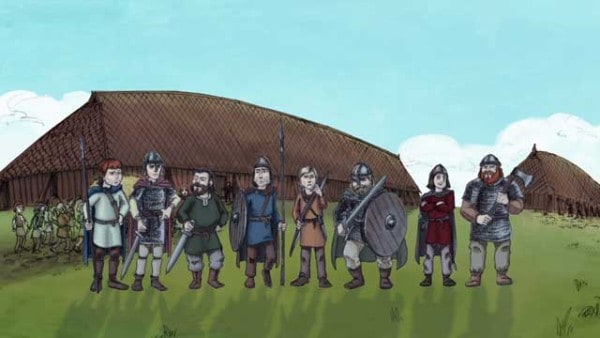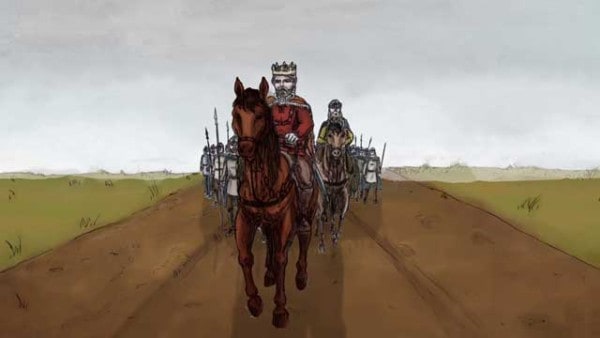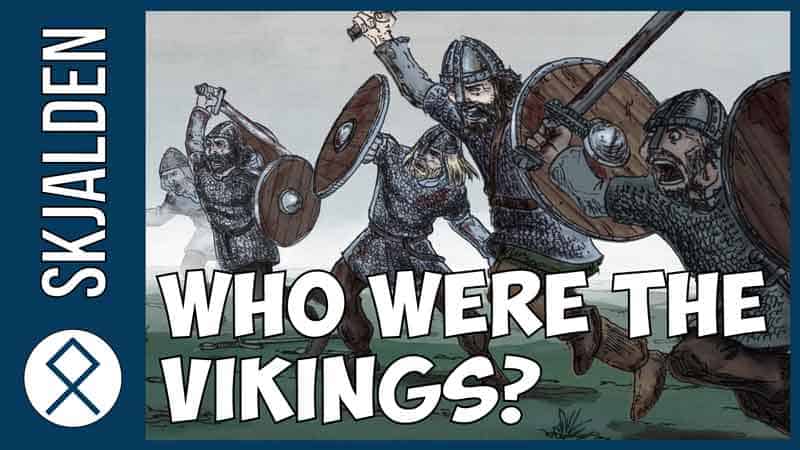The Viking society was divided into a hierarchy of four social classes. At the bottom were the slaves, above the slaves where the Karls, in the middle where the Jarls, and at the top where the royals, such as the Kings and Queens.
You were not stuck your whole life if you were born into one of these social classes. It was possible to move up and down the social latter, depending on your luck and your choices in life.
Our societies are constantly evolving and many things have changed since the Viking Age and most of it for the better. One of the major things that have changed for the better is how we view slavery. The Vikings did just like most other societies at this time in history have slaves, but fortunately, it is something that is almost eliminated today.
Being a slave in the Viking age, was as you can imagine not a very good life. You were at the mercy of your owners, and they could do pretty much anything to you that they wanted. A slave or as it is called in Danish “træl” (Old Norse: þræll) had no personal freedom, something that is even implied in the word træl (Old English: thrall), which literally means an unfree servant.
The first social class in the Viking age
According to the old Norse sagas, it was the thralls (slaves) who were the first class of mankind. For you see, while it was Odin and his two brothers who created the first two humans from an elm tree and named them Ask and Embla.
It was the God Heimdall who created the four social classes when he traveled around Midgard (Middle-Earth) under the name Rig while wearing a disguise. This story is told in the saga “the lay of Rig (Norse: Rígsþula), but let me summarize the most important parts of this old Norse saga.
The lay of Rig summarized
Rig arrived at a shabby old house, where he met an old couple dressed in ragged clothes, their names were Ái (Great-grandfather) and Edda (Great-grandmother). They invited him into their house to stay for the night and gave him some food to eat. The food was the best the could offer him but it was still of very low quality, it was just some soup and a swollen loaf of bread stuffed with grains.
Rig stayed with the couple for three nights, and every night he slept between them in their bed. Nine months later Edda gave birth to an ugly boy with a crooked back, and they name him Thrall (Slave). Thrall grew up doing the typical slaves jobs, such as firewood gathering and feeding the animals. One day he met a woman named Thír, who is described as filthy, with scars on her feet, sunburnt arms, and a hook nose.
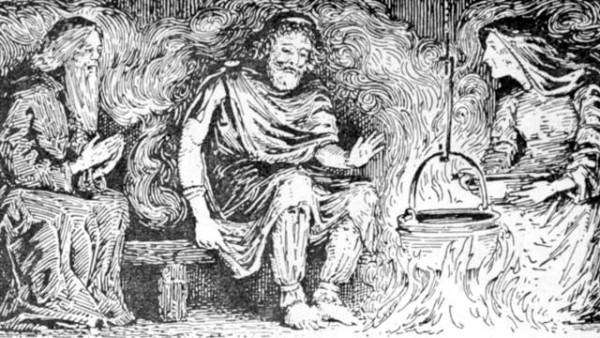
Together Thrall and Thír had many children and the names of their sons where, Lumpy, barn cleaner, noisy, horsefly, sleeper, stinker, midget, fat boy, slow and gray hair, hunchback and dangle leg. The name of their daughters was, shorty, fatty, fat calf, beak nose, shriek, slave girl, gossip, skinned hips, and bird legs. Their children also grew up like themselves doing typical slave jobs, such as, feeding the animals and planting the fields.
Next Rig visited Afi (Grandfather) and Amma (Grandmother), their house looked a little better than the previous couple and they are dressed much nicer. Rig stayed with the couple for three nights, and nine months later Amma gave birth to a boy, with red hair and keen eyes, who was given the name Karl. The boy grew up doing typical farming stuff, such as plowing the fields and taming cattle.
When Karl became a young man he met the woman Snør, who he married. The couple had many children together, the names of their sons where, manful, fighter, brave, swordsman, smith, stout farmer, trim beard, rancher, husband, sharp beard and manly. The names of Karl and Snør’s daughters were, smart, bride, swan lady, dame, girl, noblewoman, wife, shy, and vivacious.
Rig kept traveling and came across a big house, where he was invited inside by the couple Módir (Mother) and Fadir (Father). The couple was dressed very nicely, the woman was described as wearing a headscarf, jewelry, a long dress, and a blue blouse. Blue dye was very expensive in the Viking age, so this shows that the couple had plenty of silver between their hands.
The woman was very beautiful and she had skin as white as snow, “white skin was associated with beauty in the Viking age” because it was a sign that she didn’t work outside very much like the lower classes did.
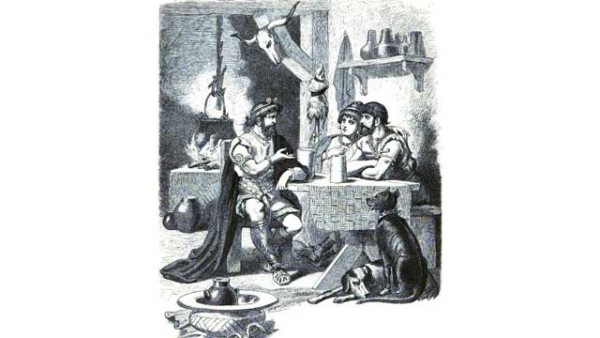
Rig sat down at the table and ate a meal with the couple which consisted of sliced white bread, meat and poultry, and wine. Rig stayed for three nights and slept between the couple, nine months later Módir gave birth to a son. They named their son Jarl, his hair was blond, he had bright cheeks and snake-like eyes.
His father taught him how to ride a horse, hunt with a bow, fight with a sword, and throw a spear. As Jarl grew older, Rig would come back and visit him again and again. He would teach him how to read runes and encourage him to fight and conquer lands.
Jarl would eventually get married to Erna (Eagle Lady), who is described as being smart, white and having soft hands. Together they had many children, but it is probably their last son who is the most important one, his name was Konr, which means King.
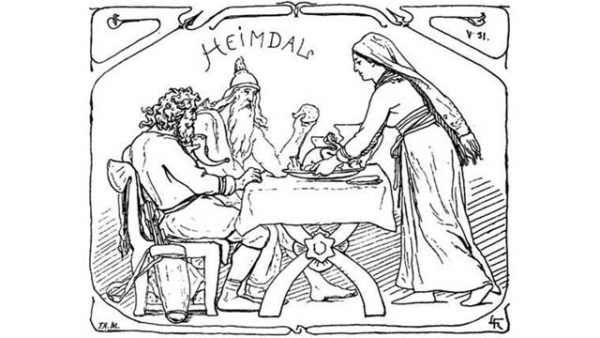
Fadir taught his sons the same things as his own father taught him, but Konr was a very smart boy, so he also learned how to cast runes, use spells and he even learned to understand the language of the birds. As Konr got older he became smarter and he even began to understand the runes better than Rig.
From this story, we can see how the Vikings believed that the four social classes in the Viking society came into existence. So as I said earlier, it was the Thralls who was the slaves and on the bottom of the social classes. The Karls who was the farmers and above the slaves (Thralls), and the Jarls who was the noble class, and finally the royal class who were descended from Konr. There was, of course, also a lot of diversity within each class, some owned land, and some didn’t, and some were richer and than others had hardly enough to scrape by. This was especially the case within the Karls and Jarls, where the economic diversity could be huge.
Slave trading in the Viking age
The slaves were amongst the most important commodities traded by the Vikings. While it was primarily from raids and their expeditions to the Britsh Isles and in Eastern Europe that they got their slaves, they did also enslave their own kind in their home countries. For instance, it was not uncommon to see Danish slaves on Iceland, Swedish slaves in Denmark, and Norwegian slaves in Sweden.
The people within the Viking society could also be punished with slavery if they had committed a crime or was unable to pay a debt. Crimes that were often punished with slavery, were crimes like murder and thievery.
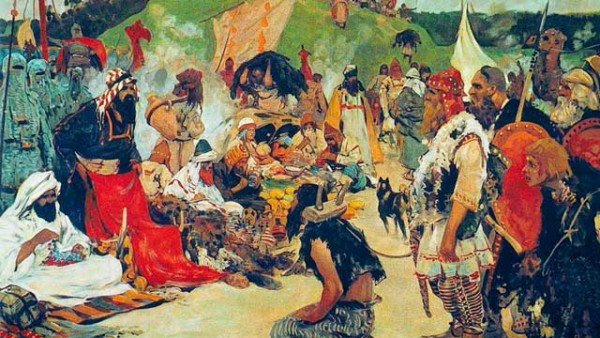
It was easy to spot a slave, because the universal sigil of the slave in Scandinavia was the slave collar around their neck, combined with shortcut hair, the female slaves, may have been allowed to have a bit longer hair than the male slaves, but probably not as long as the lady of the house. The slaves wore very simple and cheap clothes, with no colors, since dye was considered too expensive to use on a slave’s clothes.
If a child were born to a slave, then the child was also a slave to the same owners. If another person killed another man’s slave then he had to pay the value of the slave, just as if it was an animal like a cow or a pig. If he were unable to pay for the damages, then he could end up as a slave himself, until he had paid his debt in full.
We have many written sources that tell us about the slave trade in the Viking age, however, bear in mind, that most of these sources have been written by non-heathens.
Slave trading was not something new in the Viking age, it had existed for many thousands of years, and many of the territories that the Vikings conquered where already part of a very profitable slave trade network.
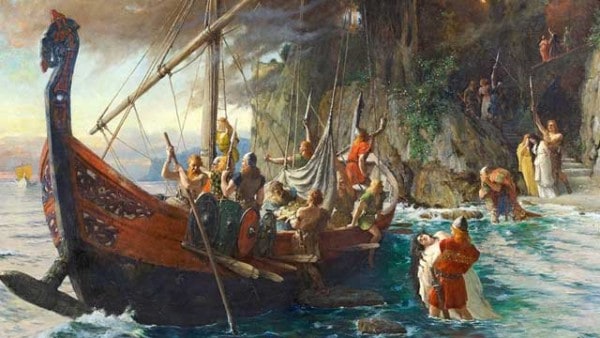
Trade towns such as Ribe (Riba), Hedeby (Haithabu), and Birka were used by the Vikings to trade their slaves for other products. The buyers bought the slaves for all kind of uses, and if the slaves were strong and fit they would probably have been used for hard labor such as farming, while others might have been used in the household to cook and clean, but it was pretty much in all kind of hard manual labor that they used slaves.
It is also speculated that some of the huge building projects in the Viking age were built with the help of slaves, such as the Viking wall in southern Denmark called Dannevirke and the Viking fortresses.
The Vikings were of course not the only group of people who were in the slave business, another big player in the market in Europe was the Christians. However, unlike the heathens, the Christians did not like to see their own kind being forced into slavery, something that was also forbidden by the Church.
Origin of the word slave
While many slaves did come from the Britsh Isles, it could be argued that most of the slaves in the Viking age came from Eastern Europe, since the term slave originates from the Slavic peoples of Eastern Europe.
Especially when we think of both the expansion of Christendom into the east and the Vikings pursuit of riches and fame into literally all directions. The Slavs must have experienced a tremendous pressure at their borders, where they were attacked, murdered and enslaved by much stronger societies.
Slaves’ rights in the Viking Age
As you probably can imagine it was not a very good life to be a slave, not only did slaves have no personal rights the owners could treat them exactly as they wanted. Slaves were not even referred to, by using a masculine or feminine gender, but instead, they were referred to by using the neuter gender.
The owners were allowed to beat their slaves if they did not behave properly or listen to the orders they were given. The owners could also sexually exploit them, which is something that was observed by the Arabic diplomat Ibn Fadlan at the river Volga in eastern Europe. A person who always seems to talk so nicely about the Vikings, and totally with no biases towards them at all…
“They are the filthiest of God’s creatures. They have no modesty in defecation and urination, nor do they wash after pollution from orgasm, nor do they wash their hands after eating. Thus they are like wild asses.”
“When they have come from their land and anchored on, or ties up at the shore of the Volga, which is a great river, they build big houses of wood on the shore, each holding ten to twenty persons more or less.”
“Each man has a couch on which he sits. With them are pretty slave girls destines for sale to merchants: a man will have sexual intercourse with his slave girl while his companion looks on.”
“Sometimes whole groups will come together in this fashion, each in the presence of others. A merchant who arrives to buy a slave girl from them may have to wait and look on while a Rus completes the act of intercourse with a slave girl.”
Slaves could gain their freedom
Being a slave in the Viking society did not necessarily mean that you where bond in that role for the rest of your life. A slave could purchase his or her freedom if they were able to pay their owners either their purchase price or their current worth.
Some of the slave owners granted their slaves a little personal freedom, so they had a little time where they could make products such as baskets, which they then were allowed to sell, and in that way, they could earn enough money over time to pay for their freedom.
The owners could also grant them their freedom if they had been a good servant for them. The slaves that were unable to gain their own freedom, would often follow their master into the grave, to serve them eternally in the afterlife. An example of a slave gaining his freedom can be found on the rune stone from Hørning in Jutland.
The runestone reads as follows: tuki : smiþr : riþ : stin : ift | þurkisl : kuþmutaR : sun : is : hanum | kaf : kul : uk : frialsi
In English: Tóki Smith raised the stone in memory of Þorgísl Guðmundr’s son, who gave him gold and freedom.
Another example of a slave gaining her freedom is from the book the life of Ansgar that was written around 875 CE. Here it is described how a monk witnesses Christian slaves for sale in the Danish trade town Hedeby in southern Jutland.
According to this book, a monk sold all his possessions even the horse he was riding on to purchase the freedom of the slaves. While this seems like a heroic act, it actually shows how the Church only cared about saving their own from slavery.
However, even when a slave gained his or her freedom, they were still tainted by it, and it could take up to four generations before a family would regain all their rights and honor within the society.
Viking Social Structure: Thralls, Karls, Jarls, and Kings
Karls the working class in the Viking age
Most of the people in the Viking age were Karls, and these people would be considered the working class in our modern society, even though they were just one step above the Thralls (slaves). The word Karls also indicate that these people where free, since the word Karls literally means “freemen”.
The Karls were the farmers, craftsmen, fishermen, merchants, and boat builders, they were the people who made the wheel turn so to speak. The Karls who were farmers either own their fields or rented them from those who owned large plots of land.
It was hard to be a farmer back in the Viking age, everything was hard manual labour and most of it had to be done by hand or by using an animal, and because of this, many of the farmers used slaves that had either bought at one of the many trade towns, or paid other Karls who could not afford to own or rent land.
The lack of fertile land in Scandinavia during the Viking age was a very big problem, and it was one of the many reasons why some of the Vikings eventually would settle down in other areas such as on the British Isles.
While Karls were freemen, they still had some duties to perform within their society, so when a young Karl entered adulthood, they had to pledge his allegiance to the local Jarl. Which meant that the young Karl promised that he would be available to help the local Jarl if he, for instance, needed his assistance in case of an attack or if the Jarl needed his help to plant or harvest the fields at his farm. A Karls also paid taxes to the local Jarl, these taxes were paid in either silver or as a percentage of their harvest.
Jarls the noble class in the Viking age
The Jarls (Earls) was the noble class in the Viking age, and they functioned as the local chieftain. The Jarls was usually chosen by the Karls (freemen) within the local society, but they could also claim this position with force or if they were very rich.
The Jarls owned huge plots of land, but they did not get their hands dirty or work in the fields like the Karls. The Jarls just managed their farms and used slavery to get the work done or rented some of their lands to the Karls.
Today the Jarls would be considered the upper class since they had the highest social status, only one step below the Royals. Which meant that they were very powerful and had a lot of silver to spend on planning and conducting raids towards other clans, or even in lands far away, in their neverending pursue to gain more riches and influence.
However, most of the warriors that took part in the raids were the Karls, the freemen, who in payment for their participation in these raids got a small slice of the treasure, but unlike the Jarls who were all trained in combat, the Karls only had basic fighting experience, and they even had to bring their own weapons, which mostly were only spears, axes and shields.
There is no doubt that it was the Jarls who were among the best equipped Vikings and some of the Jarls even had swords, which was a rare weapon, and definitely a weapon that could decide the outcome of a battle if it was wielded by a skilled swordsman.
Kings in the Viking age
The highest class in Scandinavia in the Viking age was the Royals. However, Kings and Queens was kind of a new phenomenon in Northern Europe, because, for the most part of the Scandinavian history, the society consisted of small clans, which mostly where ruled by a Jarl.
The Kings were either people who were former Jarls or people who had with force-placed themselves on top of the pyramid, which means that the role of King or Queen was not something that someone would automatically inherit by blood.
All the Jarls within the Kingdom was loyal to the King, and they had to provide both manpower if needed to fulfill the Kings wishes and collect taxes from the Karls in their local community.
A King had tremendous power, and he had the ability to plan raids and gather huge armies to attack other cities in foreign lands, such as on the British Isles. It is also when we start to see the first Kings in the Viking age that we begin to see clans form together and eventually end up as a part of a unified country.
This gave the Kings the ability to gather a large group of people to make mega constructions such as the Viking wall called Dannevirke, or the big Viking fortresses that are spread across southern Scandinavia.
All social classes were part of agriculture in one way or another, and the same was also the case for the Royals, and just like the Jarls they owned huge plots of lands, that they either rented to the Karls or used slaves to cultivate.
However, the most important role of the King was to protect the Kingdom and to plan and lead the military expeditions.
It was of course too expensive to have a starting army all year round, so the King had his own little personal army which consisted of an inner circle of very loyal Jarls. These Jarls were paid personally by the King to protect him, and they accompanied him everywhere on his expeditions, regardless if it was abroad or when he traveled around the Kingdom.
There were also unwritten rules for the King, and it was expected that he was generous and shared his riches in form of gifts and parties to the Jarls and Karls. If a King was selfish, he could lose his support, which could lead to a revolt against him, in which there are many examples of from the Viking age in Scandinavia.
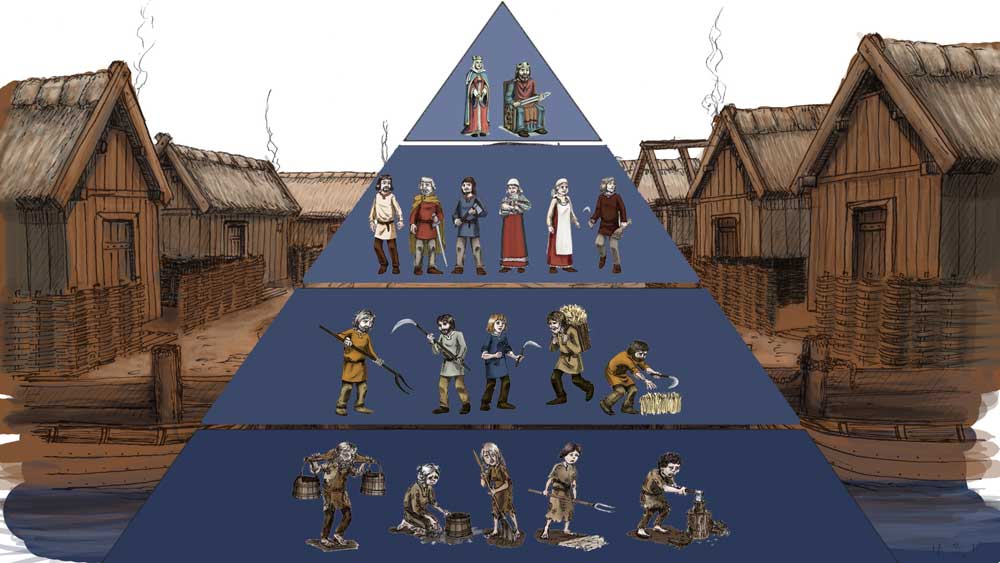
However, it was not all Kings that were treated with the outermost respect, especially those who came from outside of Scandinavia or as we say in Denmark “uden for den danske andedam” which literally means “outside of the Danish duck pond”. An example of this can be seen when the Danes meet the King of the Franks, King Charles the simple.
“In the presence of the king, the Danes were ordered to show their submission by kissing the foot of the king. The leader of the Danes refused. One of his followers complied. But, rather than kneeling to kiss the foot of King Charles, the Dane stood, grabbed the king’s foot, and lifted it up to the level of the Dane’s own head, dragging the king out of his seat and onto the floor. With the king held upside-down, the Dane kissed the foot.”


